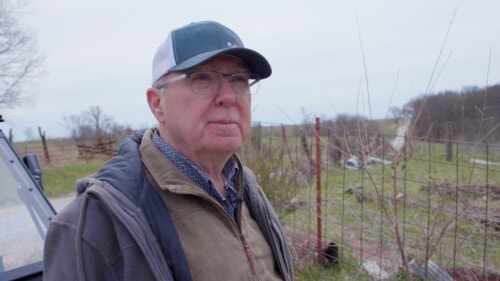Kansas Farmer Brings Renewable Energy Future to Concordia Cloud County Community College Embraces Green Energy Revolution to Ensure Community’s Future
Published April 3rd, 2024 at 6:00 AM
Above image credit: Bruce Graham, former head of the Renewable Energy Department at Cloud County Community College in Concordia, Kansas, stands in front of a wind turbine. (Haines Eason | Flatland)CONCORDIA, Kansas — The very picture of a farmer, Bruce Graham is tall and sturdy. Clean-cut and soft-spoken with work-thickened hands and patience that seems grown from working the land, he and his family have farmed and ranched for generations.
If one had only a single word to describe him, it might be one not particularly in vogue these days: balanced. Many others could do. Pragmatic. Kind. Inquisitive.
The fascinating thing about Graham is that as you get to know him, more words keep coming to mind, and he unfolds into an unceasingly surprising man whose outward demeanor belies a mind that never stops moving, especially when it comes to making the world a better place.
“If somebody says, ‘What’s your motto?’ or ‘What’s your goal?’ or ‘What do you live for?’ my idea is to make everywhere I go better than when I got there,” Graham said recently.
Now retired, Graham was the architect of the Renewable Energy Department at Cloud County Community College (CCCC), where he has nurtured an idea into a groundbreaking program offering multiple degrees and certificates to dozens of students from Kansas and beyond.
While his sentiments may strike some as a little cliched, Bruce’s sincerity gives them a compelling resonance. You can’t help but nod as he shares them.
“Before I leave, I want where I was to be better, and I’ll go on to somewhere else and I’ll make it better, and I’ll go on to somewhere else,” Graham said. “And it may only be picking up cigarette butts off the ground. It might be picking up an aluminum can and recycling it. Very small things. But as you do all of those and you put them all together in a lifetime, it makes a difference.”
To Lead it, You’ve Got to Live It
“We decided we wanted to do some kind of renewable energy for our farm,” Graham recalled. “We decided to get into renewables because of our full belief that we need to take care of our Earth. It’s one of those things that if we don’t take care of it, it won’t be here for our children.”
Graham was standing in his driveway, summer of 2023, and the sun was blazing down. There was a significant drought on, and a sizable part of the state’s crops were withering in the heat.
Withering is too mild a word — the crops seemed to have been nuked. In many parts of the state, including in Graham’s area, farm ponds were running dry. His own was a puddle, down from two-plus acres when full and 10 to 12 feet deep at the dam.
Graham and his wife Michelle considered a small wind turbine for several years, but they decided the expense and moving parts were too complex to overcome.
“We looked into solar energy, and solar energy was becoming more and more efficient, and we decided we would try the solar route,” he said.
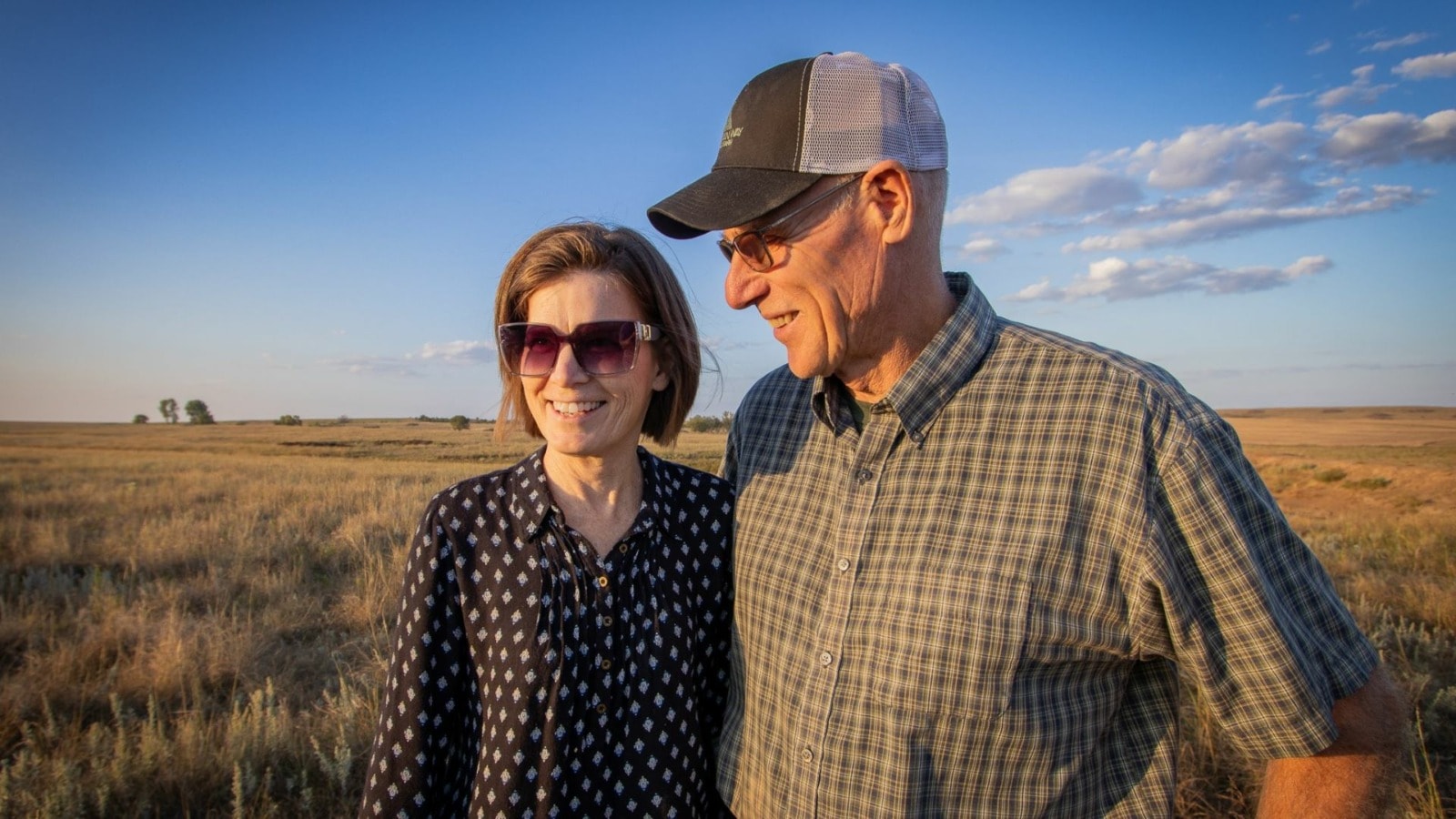
The Grahams now have two arrays that combine to mitigate their electric bill. It seems simple — problem, solution. But what one learns while spending time with Graham is it’s not the conclusion but the journey that is awe-inspiring.
Graham researched the panels and supporting infrastructure himself. He installed both arrays himself. He can maintain the panels himself.
And, when you zoom out, an even more impressive picture comes into focus. He and friends and family helped build the house in which the Grahams live. He does much of his vehicle maintenance. Graham also ranches, expertly maintains his property, and is an active member of his church and local community.
And, all this innovation and hard work happened in the shadow of a career, one spent growing the renewable energy career offerings at Cloud County Community College in Concordia.
Community College Leans into Renewable Energy
Amber Knoettgen, president of Cloud County Community College, is frank and focused. Kind, but business oriented. She’s on a mission to ensure the college’s growth is sustainable. And she’s seen Bruce Graham become an integral part of the college’s success with renewable energy career training.
“Bruce is a pioneer,” she said. “He’s a visionary. He brought the idea to the college, and he really built it… I think Cloud’s wind energy program and Bruce Graham are synonymous. I don’t think you have one without the other.”
Lots of people have ideas. And they build programs through grants and intentional recruiting. These are not uncommon occurrences.
But programs that thrive — programs that spring from nothing and become landmarks in their own right — those have something extra, an ethos or culture that isn’t easily found and is hard to foster. These latter essential ingredients often spring from people or a person who is willing to do what it takes to see their dream take root and grow.
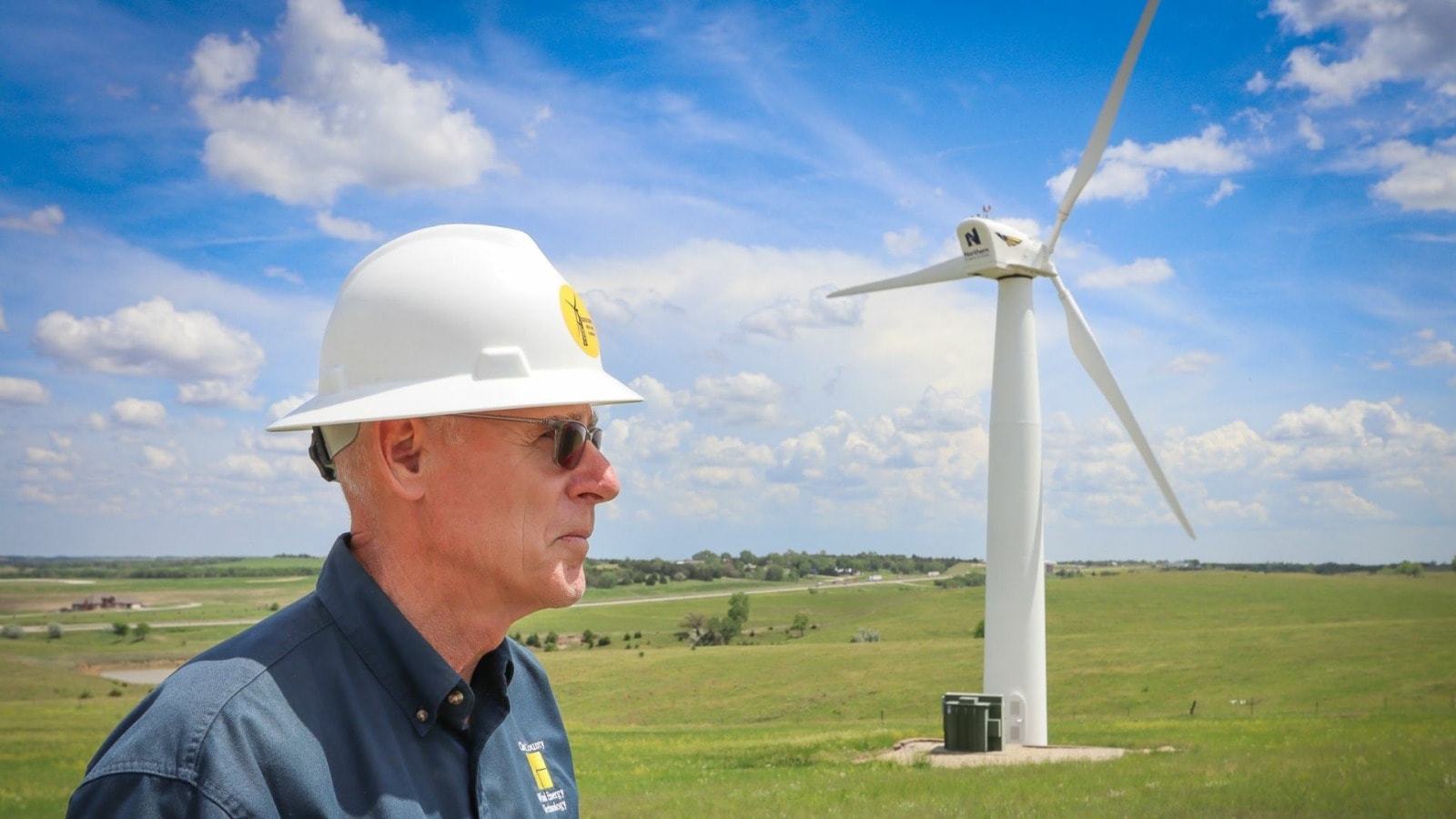
The Kansas Board of Regents approved CCCC’s wind energy technology program in March 2004. Graham was hired in the summer of 2007 to get the program up and going. And since it began offering wind energy training courses in the fall of 2007, CCCC has added innovative programs roughly every two years through 2018:
- Fall 2007: Cloud County Community College offers an AAS degree and a 36-hour certificate in wind energy technology.
- 2009: The college adds a certificate in wind energy assessment and development.
- 2010: A 16-hour wind energy blade repair certificate is added.
- 2013: A 33-hour substation technician certificate program launches.
- Fall 2016: CCCC becomes one of the few higher education institutions in the country to offer a certificate (30-hour) and AAS degree in unmanned aircraft systems (drones).
- Fall 2018: CCCC launches a 33-hour certificate and an AAS in solar energy technology.
To encompass the growing diversity of programs under the renewable energy banner, the department was aptly renamed Renewable Energy in the fall of 2018.
“Bruce always takes it a step further, makes sure it’s brought across the finish line. He has a vision and somehow is able to see it ahead of others. And he’s able to also explain it in a way that’s easily understood,” Knoettgen said.
And, when you’re talking about energy generation and transmission, that’s no small feat. Wind turbines have nuanced and specific parts with a myriad of integrated functions. Graham can cut through the complexity of calibration, managing vibration and wear to help students understand the core principles.
“He’s just a natural teacher and is able to explain things in a way that someone that doesn’t have a technical background would understand,” Knoettgen said.
The Right People at the Right Time
Graham’s gift as a leader is his ability to remain resolutely open-minded, whether to a person or an idea. He centers himself and waits to see what there is to be seen or heard.
“He’s good at seeing opportunities and encouraging folks with the right skills to fill those gaps,” says longtime Graham friend and CCCC colleague Monte Poersch.
Poersch has been an instructor at CCCC since 2011 and counts Graham as a close friend and mentor.
“I think a primary skill of a leader,” Poersch said, “is to be able to say: ‘Look, I’m not going to do, I want to grow my people. I want to see them stick around. I want to give them opportunities that are going to use their skills.’ So, I bet if you pushed him on it, he’d say he saw our skills and desires and actively encouraged them.”
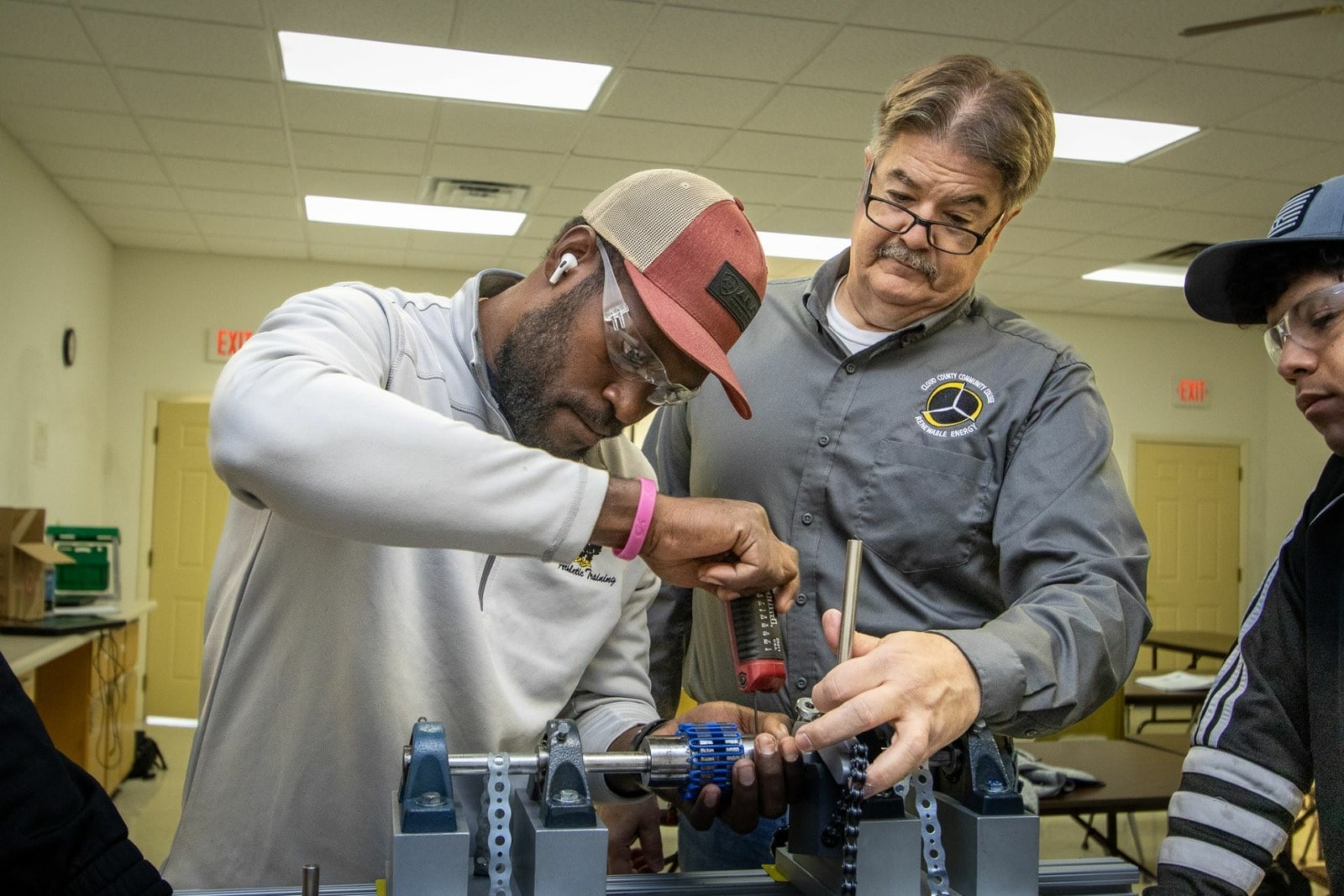
On the one hand, Graham will see a project through — an essential skill for any leader who’s trying to start something new.
“There are a lot of projects, and a lot of people have great ideas, but they’re not able to follow through,” Knoettgen notes. “Not because they don’t want to. Maybe they don’t have the tools, or the time. But Bruce, he just goes and gets what he needs to make sure that it gets done.
“If that’s money, he helps write a federal grant. If that’s the understanding, the industry support, he goes out and makes the connections. If it’s the students, he goes and visits the high schools to recruit the students to come and enroll here. So, there’s really nothing Bruce wasn’t willing to do to see wind energy brought to Cloud.”
On the other hand, though, Graham, along with Knoettgen and others at the college, made hires he knew had the passion and drive to grow the department.
“Bruce and I had a lot of conversations. ‘What’s the next thing? Okay, now, what’s the next thing?’ We’re both big-picture guys, and me, I get real bored with the status quo and just doing the same thing every day. And that’s when we started talking about, well, how are we going to inspect these wind turbine blades? And that’s when we launched the drone program.”
A leader with a strong hand might have overthought new ideas and seen them as a challenge to the status quo or any accrued success — why rock a boat that’s on a good course? According to Poersch, though, Graham always took the more difficult path, asking himself what his colleagues’ passions and greatest skills were, and how those could be incorporated into the life of the Renewable Energy Program.
A New Building for a New Era
Nothing quite marks the progress of an institution like a new building.
In March 2023, Cloud County Community College broke ground for a new Technical Education and Innovation Center, and the building is expected to be completed before the 2024 fall semester.
Since its inception, the Renewable Energy Program has made its home in a utilitarian metal-sided building situated just west of Blosser Municipal Airport, separated from the main campus by U.S. Highway 81. Overflow classes are held in a nearby strip mall storefront.
While the metal-sided building effectively supports the kinds of hands-on instruction needed to teach the technical ins-and-outs of renewable energy careers, the program has outgrown it and the building itself is aged, shows its repairs, and appears to have been expanded a few times without an overarching plan.
Priced at $18 million and at nearly 34,000 square feet in size, the new Technical Education and Innovation Center will house the Renewable Energy Program as well as Nursing and Allied Health and Agriculture and Industrial Technology. Given its large, eye-catching, and glass-fronted main entrance and its position on a rise that is clearly visible from the highway, the college’s focus on renewable energy, health and agriculture is clear.

It’s Always About the Students
In business, if you take care of your people, chances are they’ll take care of you and your enterprise. Same goes for any field, really. In education, if you look out for the welfare of your students, they’ll stick around, graduate and they’ll spread the word.
One such student had spent his entire high school career trying to get into McPherson College’s highly regarded automotive restoration program. Being one of the top programs in the nation, it took a lot of work to get in, and this student had put in the effort.
“I got in, but Bruce Graham was starting the Cloud County Wind Program… He had quit his teaching job at one school, and then he ended up filling in a teaching job at my high school for a year. That’s how our paths crossed,” remembers Rylan Everett, now living in Broken Bow, Nebraska, and working as a wind operations and maintenance manager with RWE Clean Energy.
“He talked me into it the day before I graduated, switching from automotive restoration that I’d spent my whole damn life trying to do into wind,” Everett recalled with a laugh. “He had one little PowerPoint, and between the PowerPoint and just trusting the guy, the rest is kind of history.”
Everett had compiled a lot of information on his college of choice, including, naturally, the cost to attend.
“It’s a private college, and, at the time, they wanted $23,000 a year tuition,” Everett said. “I calculated a total cost around $89,000. Now, I had big scholarships, but it was still 90 grand.
“And Bruce was just showing me the numbers. He’s like: ‘There are jobs. This is a very exciting industry. There’s lots of jobs.’”
Everett pivoted and came to CCCC with Graham. And, sure enough, things moved in a positive direction. After one year at the college and a summer internship after that, Everett secured a solid job offer with wind turbine installer and servicer Vestas.
“I went to Bruce, and I said: ‘Gosh, Bruce, what do I do? Do I take this job, or do I finish my degree?’ And he said: ‘Hey, the main reason to go to college is to get you a job. Sounds like you already have one.’ So, I basically dropped out and really haven’t looked back since.”
Down at the Bottom of the Pond
Bruce and Michelle Graham’s farm sits not far from the town where they met, and where they went to high school together: Miltonvale. The circle of people who know and love them is large. And they’ve had an outsized impact on their town and their region, too.
Like Bruce, Michelle has also made a career in the renewable energy sector as an operations administrator with EDP Renewables at the Meridian Way Wind Farm found east of Concordia.
Recently, they were standing at the bottom of what had been the Grahams’ largest pond, and at what once would have been 10 or so feet underwater. They had ridden a utility vehicle out through their fields to check on their cows, see the pond and get a view of their property. The setting sun cast a yellow-umber glow over the scene, adding gravity to the outing.
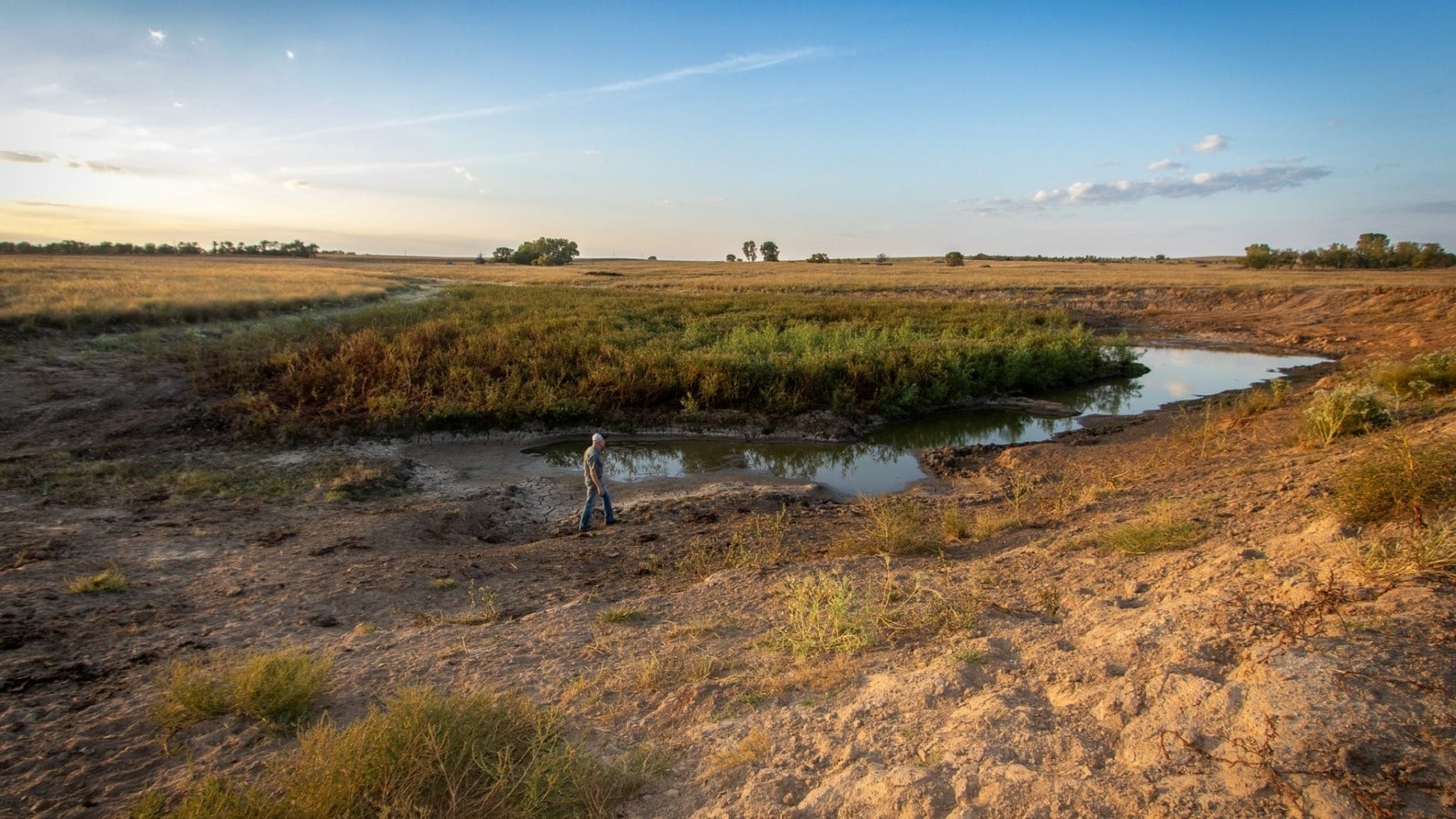
The Grahams and many other farmers and ranchers in the area had resorted to hauling water to their herds, a time-consuming, difficult and potentially costly job.
The entire Graham family is “all-in” on renewables. Their son Connor also works for Vestas.
Standing at the bottom of the dry pond, one could see why they would be “all-in.”
“We’re basically cooking ourselves,” Bruce said, noting a list of recent extreme climate events before refocusing on his own dry pond.
“This here, this is really why we need renewable energy, solar, wind. We can’t do it just with solar and wind. We have to have fossil fuels, but we have to use less and less of them, or we’re going to cook ourselves.”
Flatland contributor Haines Eason is the owner of startup media agency Freelance Kansas.



